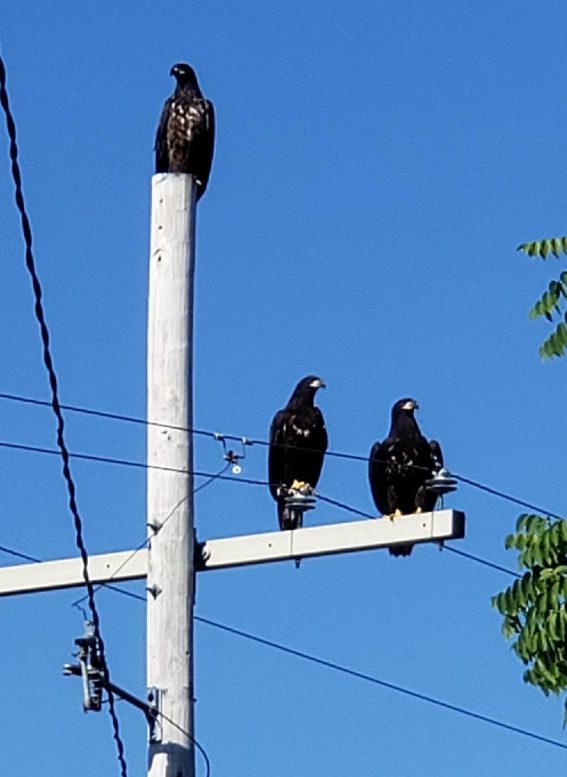By JAN LARSON McLAUGHLIN
BG Independent News
For the last 11 years, a family in southern Wood County has shared their rural property with George and Martha – two bald eagles.
“They watch us, and we watch them,” the woman said. “I still get goosebumps every time I see them.”
The Washingtons have constructed a huge nest in a giant sycamore tree.
“They are always around,” the eagle landlord said last week. She asked that the family’s name and address not be printed. In the past, when the address was publicized, people came from all over to see the eagles – which aren’t fond of intruders.
The eagle pair normally hatch two eaglets each spring. But this year, George and Martha parented triplets – a feat that occurs just 15% of the time for bald eagles in this region, according to the Ohio Department of Natural Resources.
Further south, near Findlay, another eagle pair had triplets. In that case, the Ohio Department of Transportation was required to keep an eye on the bald eagle nest since a nearby bridge was being replaced on U.S. 68 at Ohio 15.
The baby eagles are far less regal looking than their parents.
“They look like vultures,” the Wood County woman said. “They don’t get their white feathers for three or four years.”
The nest gets pretty noisy at meal times.
“You can really hear when they bring food in,” she said.
And other times, the parents sit in a nearby tree, watching and singing to their babies, she said.
“It’s this amazing song to their kids.”
The couple decided against naming the triplets since they tend to take off and not visit again. There have been times when the youngsters try to come back – but aren’t welcomed back by their empty-nester parents.
It usually creates quite a ruckus, with a lot of screeching, when young eagles try to return home.
“They aren’t welcome to come back here,” she said.
Full-grown, the bald eagles can stand about 3 feet tall, with a wingspan of about 6½ feet.
The woman recalled her first glimpse as one of the bald eagles hovered over their land. “It was like this airplane.”
In the case of the southern Wood County pair, they commandeered an old red tailed hawk’s nest in 2009 – and added on.
“The nest is huge now,” the woman said, her husband estimating the nest to now be up to 6 feet in diameter. A bad storm one year caused part of the nest to cave in. But George and Martha gathered more limbs to rebuild.
“A lot of times you can hear them, but not see them. The nest is huge,” she said.

According to the National Wildlife Federation, eagle nests, also called aeries, can be 6 feet across and 6 feet high, and can weigh over a ton.
During the summer, the sycamore tree provides camouflage, since its leaves are bigger than paper plates.
The eagles’ human neighbors look out for their lodgers. The couple contacted ODNR and American Electric Power after an eaglet was electrocuted one year as he took off from a power pole. AEP put fiberglass tops on the pole to prevent that from happening again.
As scavengers, eagles aren’t particular about the expiration date on foods. The family recently saw one of the adult eagles studying a dead raccoon that had been on the road for about a week. The family has found tortoise shells, and skulls from other small animals like rabbits.
They have heard of pet collars being found in some eagle nests, but the Wood County couple has not lost any pets to George and Martha – despite a brave encounter with one of their cats and an eaglet on a woodpile.
“It has just been an amazing experience with the eagles,” the woman said.
Bald eagles are monogamous animals, maintaining the same breeding pair year after year. Bald eagles can live for about 20 to 30 years in the wild, according to the National Wildlife Federation.
A recent ODNR census counted 707 confirmed active bald eagle nests, as compared to 158 in 2007, and seven in 1973.

